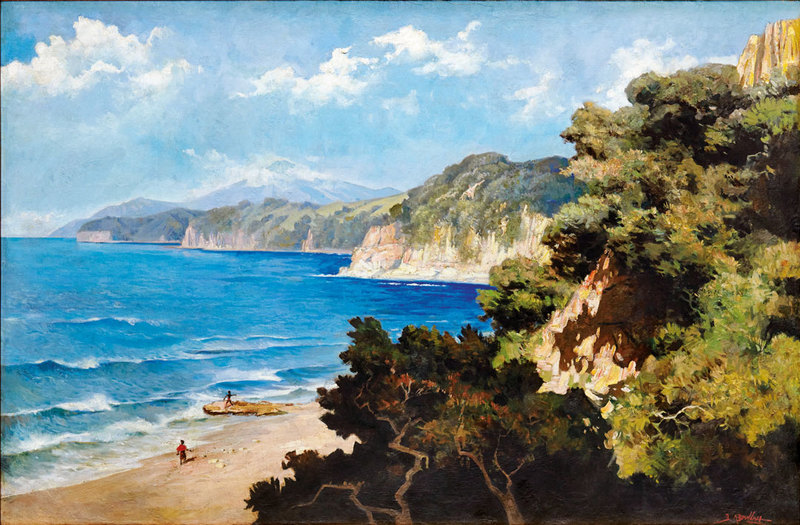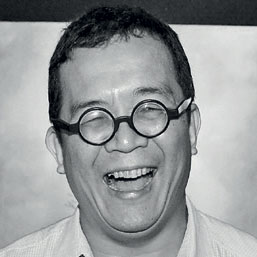Every August, for the past three years, the art collection of Indonesia’s Presidential Palaces, has been on display at the Galeri Nasional Indonesia for the public to enjoy.

The collection has been heavily based the collection of the first President, Sukarno. While only a limited number has been shown, the collection reflects Sukarno’s vision of the Indonesian nation.
It is not yet known exactly when Sukarno started his art collection. Apparently he purchased Henk Ngantung’s Memanah (preparing to shoot an arrow) following an exhibition organised by one of the Japanese bodies related to the artsin 1943. Early photographs showing the atmosphere of his house on Jalan Pegangsaan Timur 56, clearly shows that he had a number of paintings around the house. The Memanah painting can be seen witnessing the Proclamation of Independence on 17 August 1945. As Sukarno stood in front of the veranda of his house, reading out loud the words of the proclamation, behind him, on the main wall of the veranda, the painting appeared enhancing the spirit of the nation.
Photographs and film footage taken during Sukarno’s announcement of his first cabinet ministerial line-up on 3 October 1945 showed the placement of the President’s paintings in other parts of his residence. To the left of the entrance, near the window of the front porch is a small portrait of a Balinese woman, which is quite easily identifiable as a work by Affandi dated either ‘03 or ‘05, indicating that it was painted during the Japanese occupation because of the use of the Japanese Imperial (Koki) year.

Further inside the house, another painting can be seen in the photograph. While this is harder to decipher, the painting’s figure and ground is quite clear, and via vomparison with other paintings in the collection, researchers Selvi Angelita and Sabila Duhita have identified it as Basoeki Abdullah’s painting of a man walking in front of a flame of the forest (or flamboyan tree in Indonesian) that stands tall in a property behind a long white wall.
Two other photographs believed to have been taken in the afternoon of the same day, shows two other paintings. One clearly shows a Balinese painting of the activities of fishermen at sea. The painting is attributed by some experts including Adrian Vickers and Soemantri Widagdo as the work of either Ida Bagus Made Djatasura or Ida Bagus Ketut Diding. The other painting, which is only partially visible, has not been identified due to difficulties in deciphering the image.

Another photograph showing an event in November 1945, believed to be the formation of the second cabinet, shows two other important paintings in the collection of the president, both by Basoeki Abdullah. Pantai Flores is the famous painter’s reinterpretation of Sukarno’s water colour depiction of the coast on the island of Flores in East Nusa Tenggara, painted during his exile there in 1936 to 1937. Sukarno had asked his friend Basuki Abdullah to monumentalize the relatively modest watercolour depiction that he had made, enlarging the image and using more durable material, so that he could feature the imagery and symbolism of the scene more grandly at his residence.
The other painting is Basoeki Abdullah’s beautiful portrait of president Sukarno’s graceful wife, Fatmawati. The young lady, who at the time was in her early twenties, is depicted standing on a beach, dressed in a burgundy kebaya top and batik bottom with the parang rusak motif. She drapes a long, light, translucent kerudung shawl to cover her head, while her left hand holds it elegantly. In the background, a tall conical hill identifiable as Gunung Bungkuk (Hunchback Mount), north of Fatmawati’s hometown of Bengkulu, can be seen, marking where the scene is set. It indicates that the painting is set on one of the bays along the shore of the town of Bengkulu, most probably the Tapak Paderi bay.
Assuming that Sukarno did not add any artworks between the Proclamation of Independence and the end of 1945, we can say that on Independence Day these paintings were displayed at his residence:
- Memanah by Henk Ngantung
- Pantai Flores by Basoeki Abdullah
- Fatmawati by Basoeki Abdullah
- Flamboyan Tree and Man by Basoeki Abdullah
- Fishermen at Sea attributed to Djatasura or Ketut Diding
- Balinese Woman by Affandi
- an unidentified painting
Of course there may be other paintings displayed in the house. However, since these seven paintings are the ones that are known at this time, for now we can assume that these are the paintings that form the embryo of Sukarno’s collection, which a little over 20 years later, grew into a collection of around 1,500 paintings. It is indeed the most important art collection in Indonesia, and deserves to be exhibited in a separate museum dedicated to the Republic’s first President, so that his great ideas and vision can be shared by the people.
Unfortunately, this year the National Gallery will not be exhibiting artworks from the Sukarno collection, but in lieu of it this August there will be a display of artworks from a number of other Indonesian institutions including the Jakarta Museum of Fine Arts and the Ministry of Foreign Affairs.
This article is originally from paper. Read NOW!Jakarta Magazine August 2019 issue “Art & Culture – The Realm of Contemporary Arts”. Available at selected bookstores or SUBSCRIBE here.







